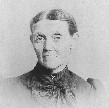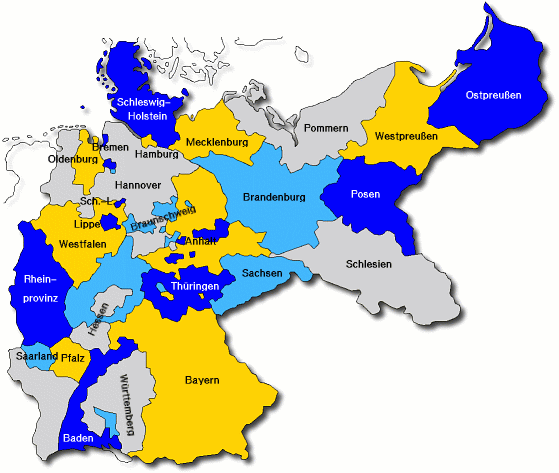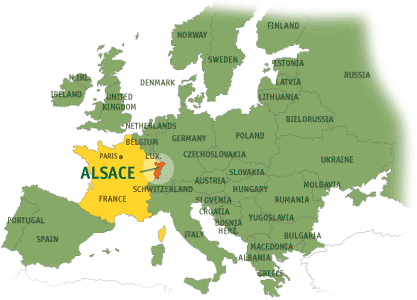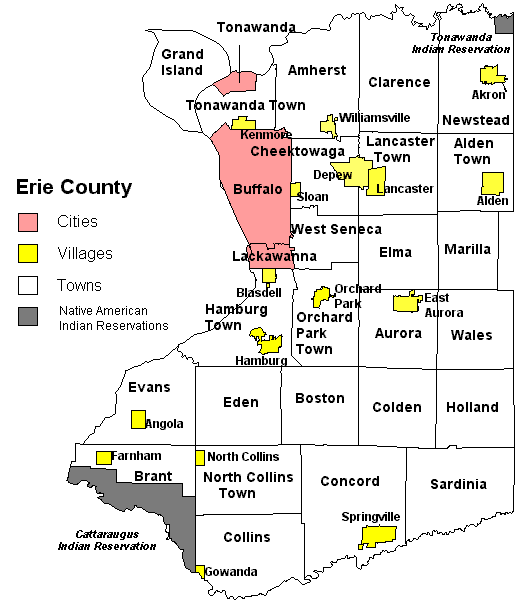Our Immigrant Ancestors from Germany and Alsace (1830-1883)
See also (on this website):
Genealogy Site Map
Alsace
Erie County
Families: Laborn - Staebell
- Voegele
Many of our ancestors originated in German-speaking lands, and immigrated to
the United States between about 1830 and 1883. This is true of all ancestors
in the Staebell side of our family tree, and most of the ancestors in the Mesker-Schneider
branch. Upon reaching America, they settled in Erie
County, New York, some in the city of Buffalo and others in the neighboring
towns and villages. The Schneider family settled across the Niagara River from
Buffalo, in Welland County, Ontario.
The History of Germany and Alsace
During most of the era when our ancestors left Europe (1830 to 1883), the nation
of Germany did not exist. "Germany" was a collection of separate states
(see the map below), many of them independent, and others under the control
of outside empires such as Austria-Hungary. Two centuries earlier, the Thirty
Years War of 1618-1648 had shattered centralized rule over Germany. During the
course of the 19th century, the kingdom of Prussia (originally known as the
state of Brandenburg), with its capital in Berlin, became the predominant military
and political power within Germany. In 1871, with the leadership of Prussia,
the numerous states unified into the modern nation of Germany.
Many of our ancestors came from a German-speaking region known as Alsace.
In the early 1800's, Alsace was part of the nation of France, as it is today,
although the people of Alsace spoke a dialect of German called "Alsacien."
After the defeat of France in the Franco-Prussian War of 1870-1871, Alsace and
the neighboring German-speaking region of Lorraine, together referred to as
"Alsace-Lorraine," were annexed to Germany. Following World War I
(1914-1918), Alsace and Lorraine once again rejoined France.
Beginning in the late 1820's and continuing through most of the nineteenth
century, many people left their homes in Alsace and the other German-speaking
states, and came to the United States and Canada, in search of a better life.
The opening of the Erie Canal in 1825 made it easy for new immigrants, arriving
in New York harbor, to reach newly available and inexpensive farmland in Western
New York and other regions further west. The Erie Canal brought a great influx
of German-speaking families into Erie County. Some were Roman Catholic, and
others were Protestant. All of our German-speaking ancestors, except for the
Laborn family, were Catholic.
Our Families
Here, in approximate chronological order, is what we know about the immigration
of each branch of our family. We know more about the origins and immigration
of some families than about others. Over time, with more research, we hope to
discover still more. Further research might also reveal that some of the information
presented here is inaccurate. To learn how these families are related, see the
family tree diagrams.
OTT, circa 1830.  John Ott and his wife, Mary Ann Meder,
with their four or five children and an orphan nephew (George), came to America
in about 1830. Their daughter, our ancestor Catherine
Ott (pictured here in her 70's), was a young girl when the family immigrated.
The family purchased a farm on Borden Road in southeast Cheektowaga,
near the border of Lancaster, in Erie County, New York. When St. Mary's of the
Assumption Catholic Church was founded in Lancaster in 1850, the Otts were among
the first active families in the parish. Catherine's older brother Louis
Ott moved to nearby Gardenville, which is a district of West Seneca, and
we have two photographs of Catherine Ott
with Louis's children at their Gardenville home. The Otts came from Kutzenhausen,
a small village in Alsace. Other Catholic Alsatians who settled in Cheektowaga
in the 1830's came from towns near Kutzenhausen, such as Surbourg
and Ohlungen.
John Ott and his wife, Mary Ann Meder,
with their four or five children and an orphan nephew (George), came to America
in about 1830. Their daughter, our ancestor Catherine
Ott (pictured here in her 70's), was a young girl when the family immigrated.
The family purchased a farm on Borden Road in southeast Cheektowaga,
near the border of Lancaster, in Erie County, New York. When St. Mary's of the
Assumption Catholic Church was founded in Lancaster in 1850, the Otts were among
the first active families in the parish. Catherine's older brother Louis
Ott moved to nearby Gardenville, which is a district of West Seneca, and
we have two photographs of Catherine Ott
with Louis's children at their Gardenville home. The Otts came from Kutzenhausen,
a small village in Alsace. Other Catholic Alsatians who settled in Cheektowaga
in the 1830's came from towns near Kutzenhausen, such as Surbourg
and Ohlungen.
SCHNEIDER, circa 1830. Peter
Schneider and Barbara Klein were born in Nousseviller-lès-Bitche,
a village in Moselle. Moselle is part of Lorraine, a German-speaking region
of France directly west of Alsace. Peter and Barbara were married in 1823 in
Nousseviller and their first five children were born there between 1824 and
1829. Their younger children apparently were born in Canada, although oral tradition
says that our direct ancestor Jacob
Schneider was born at sea during the voyage to America. The Schneider family
settled in Welland County, Ontario.
HOCK or HOCH, 1833.  Frank Hock (sometimes spelled Hoch),
father of Barbara Hock (pictured),
was only about one year old when he arrived in America in 1833 on the Brig
Ann and Emilee. About a dozen passengers named Hock, probably all related,
were on board that ship. It is not known which of the adult Hocks -- Mathias,
Mary Eva, Jacob, Barbara, Michael, and Claudius -- were Frank's parents. In
Germany, the Hocks lived in Grosswallstadt, a village in northwest Bavaria,
near Bavaria's border with Baden. In New York, from the 1830's through the 1850's,
the Hock families lived in Amherst, and attended Saints Peter and Paul Catholic
Church in Williamsville. By the 1860's, apparently after the older members of
the family had passed away, some of the family had moved to Buffalo, and later
to other parts of Erie County. (See also: Hock Family.)
Frank Hock (sometimes spelled Hoch),
father of Barbara Hock (pictured),
was only about one year old when he arrived in America in 1833 on the Brig
Ann and Emilee. About a dozen passengers named Hock, probably all related,
were on board that ship. It is not known which of the adult Hocks -- Mathias,
Mary Eva, Jacob, Barbara, Michael, and Claudius -- were Frank's parents. In
Germany, the Hocks lived in Grosswallstadt, a village in northwest Bavaria,
near Bavaria's border with Baden. In New York, from the 1830's through the 1850's,
the Hock families lived in Amherst, and attended Saints Peter and Paul Catholic
Church in Williamsville. By the 1860's, apparently after the older members of
the family had passed away, some of the family had moved to Buffalo, and later
to other parts of Erie County. (See also: Hock Family.)
FÜRST. Eva Fürst married
Frank Hock in 1857 at St. Louis Catholic
Church in Buffalo. She was born in Bavaria in about 1838, and died in Hamburg,
New York, in 1869, but little else is known about her.
HEINTZ, 1835.  We are not descendants of the Heintz family, but a few of them married relatives
of ours. John Reinhart Heintz and Marie
Cresence Wagner lived in Niederlauterbach, Alsace. They came to America
with their many children in 1835, on the ship France. Their daughter
Mary Ann Heintz married Louis
Ott, the son of John Ott and Mary Ann Meder. (After Mary Ann Heintz died,
Louis married Margaret Voegele,
a daughter of Joseph Voegele and Catherine Miller.) Mary Ann's sister Regina
Heintz (pictured), married Henry
Balthasar. Another sister, Mary
Eve Heintz, married John Schmalz
of Lancaster, and their son John
Jacob Schmalz married Mary Hock,
the daughter of Andrew Hock and Theresa
Rusch.
We are not descendants of the Heintz family, but a few of them married relatives
of ours. John Reinhart Heintz and Marie
Cresence Wagner lived in Niederlauterbach, Alsace. They came to America
with their many children in 1835, on the ship France. Their daughter
Mary Ann Heintz married Louis
Ott, the son of John Ott and Mary Ann Meder. (After Mary Ann Heintz died,
Louis married Margaret Voegele,
a daughter of Joseph Voegele and Catherine Miller.) Mary Ann's sister Regina
Heintz (pictured), married Henry
Balthasar. Another sister, Mary
Eve Heintz, married John Schmalz
of Lancaster, and their son John
Jacob Schmalz married Mary Hock,
the daughter of Andrew Hock and Theresa
Rusch.
BALTHASAR, 1837. 


 The
Balthasar family emigrated from the small village of Hoinkhausen in Westphalia in 1837 and lived
in Buffalo. The parents were Christopher
Balthasar and Suzanna Levenig. They had three sons (pictured) -- Henry,
William, and Frank
-- and one daughter, Theresa.
Our ancestor William Balthasar married Elizabeth
Clemens and was the father of Anna
Balthasar Voegele. Many photographs of this immigrant family and their children
have been preserved in Anna Balthasar's
Family Album.
The
Balthasar family emigrated from the small village of Hoinkhausen in Westphalia in 1837 and lived
in Buffalo. The parents were Christopher
Balthasar and Suzanna Levenig. They had three sons (pictured) -- Henry,
William, and Frank
-- and one daughter, Theresa.
Our ancestor William Balthasar married Elizabeth
Clemens and was the father of Anna
Balthasar Voegele. Many photographs of this immigrant family and their children
have been preserved in Anna Balthasar's
Family Album.
DRUMMER, 1846. George Drummer
and Anna Heidorn and their family were among the wave of German-speaking
Catholic immigrants who arrived in Welland
County, Ontario in the 1830's or 1840's. They probably came from Wiesenthau,
a village in Bavaria. They were passengers on the ship Meta,
which sailed from Bremen and arrived in New York in November, 1846.
STAEBELL of Alden, 1840's and 1850's. Everyone with the name Staebell
living in the United States today is probably descended from a single family,
who first appear in about 1700 in the records of Stundwiller,
a village in northern Alsace. Although our direct Staebell ancestors arrived
in America in the 1880's (as described in a separate paragraph below), they
were preceded a generation earlier by many of their relatives. Between 1846
and 1855, six or seven Staebell families immigrated from Stundwiller and settled
in the parish of St. John the Baptist Catholic Church in Alden.
Among them were two half-brothers and a half-sister of our ancestor John
Staebell: Frank Staebell
came across in 1846 on the ship Palestina; Mathias
Staebell and Marie Eve Staebell
crossed in 1847 on the ship Sweden. Many other families, probably all
related to us, came from the Stundwiller area to Alden in the same time period
-- Schenck, Ball, Fix, Klaus, Kocher, Marzolf, May, Philipps, Suttel, Uebelhoer,
Wagner, and Walter. (See also: Staebell Family.)
VOEGELE, 1847. 
 From at least the mid-1600's, our Voegele ancestors lived in the village of
Soufflenheim in Alsace. Although
Soufflenheim is only about 15 kilometers south of the Staebell home village
of Stundwiller, the two villages are separated by a forest, and there is no
evidence of contact between the Voegele and Staebell families before they came
to America. In 1847, Joseph Voegele and his wife Catherine Miller (or Müller)
and their children crossed the Atlantic on the ship Exchange. They settled
in the east part of the town of Lancaster. The gravestones of Joseph
and Catherine are among the oldest in Lancaster's St. Mary's Cemetery. Their
son Joseph married Catherine Ott
and purchased the Ott family farm in Cheektowaga. Among the children of Joseph
Voegele and Catherine Ott are Joseph Voegele
(pictured), the husband of Anna Balthasar,
and Mary Ann Voegele (also pictured),
the wife of Anthony Nuwer. (See also:
Voegele Family.)
From at least the mid-1600's, our Voegele ancestors lived in the village of
Soufflenheim in Alsace. Although
Soufflenheim is only about 15 kilometers south of the Staebell home village
of Stundwiller, the two villages are separated by a forest, and there is no
evidence of contact between the Voegele and Staebell families before they came
to America. In 1847, Joseph Voegele and his wife Catherine Miller (or Müller)
and their children crossed the Atlantic on the ship Exchange. They settled
in the east part of the town of Lancaster. The gravestones of Joseph
and Catherine are among the oldest in Lancaster's St. Mary's Cemetery. Their
son Joseph married Catherine Ott
and purchased the Ott family farm in Cheektowaga. Among the children of Joseph
Voegele and Catherine Ott are Joseph Voegele
(pictured), the husband of Anna Balthasar,
and Mary Ann Voegele (also pictured),
the wife of Anthony Nuwer. (See also:
Voegele Family.)
NUWER, 1843 and 1844.  The Nuwer family, like the Voegele family, originated in Soufflenheim
and immigrated to Lancaster. Although we are not descended from the Nuwers,
we share common Soufflenheim ancestors with them. Furthermore, Mary
Ann Voegele, the daughter of our ancestors Joseph
Voegele and Catherine Ott, married Anthony
Nuwer in 1882. Anthony was the son of John
Nuwer and Catherine Kieffer (pictured), who married in Soufflenheim in 1843
and came to America later that same year on the ship Oneida, with other
members of the Kieffer family from Soufflenheim. In 1844, John's parents Antoine
Nuwer and Marguerite Ludwig, with their children Francis
X. Nuwer and Celestine Nuwer,
came to America on the ship Argo. Once in New York, the Nuwers bought
homes in the town of Lancaster, near
Town Line. When Joseph Voegele and Catherine
Miller arrived a few years later, they bought a home not far from the Nuwers.
The Nuwer family, like the Voegele family, originated in Soufflenheim
and immigrated to Lancaster. Although we are not descended from the Nuwers,
we share common Soufflenheim ancestors with them. Furthermore, Mary
Ann Voegele, the daughter of our ancestors Joseph
Voegele and Catherine Ott, married Anthony
Nuwer in 1882. Anthony was the son of John
Nuwer and Catherine Kieffer (pictured), who married in Soufflenheim in 1843
and came to America later that same year on the ship Oneida, with other
members of the Kieffer family from Soufflenheim. In 1844, John's parents Antoine
Nuwer and Marguerite Ludwig, with their children Francis
X. Nuwer and Celestine Nuwer,
came to America on the ship Argo. Once in New York, the Nuwers bought
homes in the town of Lancaster, near
Town Line. When Joseph Voegele and Catherine
Miller arrived a few years later, they bought a home not far from the Nuwers.
CLEMENS, circa 1855. 

 The Clemens family lived in Rublinghausen,
a district in the city of Olpe in Westphalia. Three Clemens sisters (pictured)
-- Elizabeth, Josepha,
and Gertrude -- came to America
in about 1855 and settled in Buffalo. Elizabeth, who married William
Balthasar, is our ancestor.
The Clemens family lived in Rublinghausen,
a district in the city of Olpe in Westphalia. Three Clemens sisters (pictured)
-- Elizabeth, Josepha,
and Gertrude -- came to America
in about 1855 and settled in Buffalo. Elizabeth, who married William
Balthasar, is our ancestor.
LABORN, 1857. In 1857, Carl
and Sophia Laborn left their home in Medow,
Mecklenburg, Germany, with their four daughters, and in Hamburg they boarded
the ship Rudolph, sailing
for America. Unfortunately, both parents died at sea, poisoned by a fellow passenger
who fraudulently posed as a physician. (See the
Rudolph "Poison Ship" story.) Upon arrival in America, the four
orphaned daughters, including our ancestor Elizabeth
"Libby" Laborn, went to live with relatives in Niagara
Falls, New York. (See also: Laborn Family.)
MESKER, circa 1860. Little is known about the Mesker family origins.
According to family tradition, Frank Mesker
was born in Three Rivers (Trois-Rivi�res), Saint-Maurice County, Quebec. U.S.
census records indicate that he was born in 1842 or 1843 and that his parents
were born in France. When Frank came to live in Niagara Falls, New York, is
unknown. Because Frank married Libby Laborn,
a woman who possibly only spoke German, and because the name "Mesker"
is similar to "Metzger," a popular name in Alsace, it is possible
that the Meskers originated in Alsace or Lorraine.
STAEBELL of Lancaster and Buffalo, 1880 and 1883. 


 Our ancestor Frank Anton Staebell
(third picture) came to America from Stundwiller in 1880. In 1883 his parents,
John Staebell and Catherine
Schenck (first two pictures) also came over. Catherine died a few days after
her arrival in New York, and she is buried in the cemetery of St. John the Baptist
Catholic Church in Alden. John and Catherine
had many children, and all of
them came to America with their parents, or perhaps on separate ships at about
the same time. This entire Staebell family lived in Buffalo, except Frank Anton,
who lived in Lancaster and married Barbara
Hoch. (See also: Staebell Family.)
Our ancestor Frank Anton Staebell
(third picture) came to America from Stundwiller in 1880. In 1883 his parents,
John Staebell and Catherine
Schenck (first two pictures) also came over. Catherine died a few days after
her arrival in New York, and she is buried in the cemetery of St. John the Baptist
Catholic Church in Alden. John and Catherine
had many children, and all of
them came to America with their parents, or perhaps on separate ships at about
the same time. This entire Staebell family lived in Buffalo, except Frank Anton,
who lived in Lancaster and married Barbara
Hoch. (See also: Staebell Family.)
Maps
Map # 1: The German States, 1871.

The German States in 1871, at the
time of unification.
The unlabeled gray region in the southwest corner is Alsace-Lorraine.
(On this map, German-language place names are used.
"Bayern" is called "Bavaria" in English; "Westfalen"
is "Westphalia.")
Map # 2: Alsace in Present-Day Europe.

A map of present-day Europe, showing
the location of Alsace in France.
Alsace is in eastern France, on the Rhine River across from Germany,
and north of Switzerland.
Map # 3: The Townships of Erie County, New York.

Erie County is divided into townships, with three cities and a number of
villages.
Sources for the maps:
- Map of Germany:
- Map Europe highlighting Alsace:
- Map of Erie County:
Comments? Suggestions? Send a letter
to Brian...
 John Ott and his wife, Mary Ann Meder,
with their four or five children and an orphan nephew (George), came to America
in about 1830. Their daughter, our ancestor Catherine
Ott (pictured here in her 70's), was a young girl when the family immigrated.
The family purchased a farm on Borden Road in southeast Cheektowaga,
near the border of Lancaster, in Erie County, New York. When St. Mary's of the
Assumption Catholic Church was founded in Lancaster in 1850, the Otts were among
the first active families in the parish. Catherine's older brother Louis
Ott moved to nearby Gardenville, which is a district of West Seneca, and
we have two photographs of Catherine Ott
with Louis's children at their Gardenville home. The Otts came from Kutzenhausen,
a small village in Alsace. Other Catholic Alsatians who settled in Cheektowaga
in the 1830's came from towns near Kutzenhausen, such as Surbourg
and Ohlungen.
John Ott and his wife, Mary Ann Meder,
with their four or five children and an orphan nephew (George), came to America
in about 1830. Their daughter, our ancestor Catherine
Ott (pictured here in her 70's), was a young girl when the family immigrated.
The family purchased a farm on Borden Road in southeast Cheektowaga,
near the border of Lancaster, in Erie County, New York. When St. Mary's of the
Assumption Catholic Church was founded in Lancaster in 1850, the Otts were among
the first active families in the parish. Catherine's older brother Louis
Ott moved to nearby Gardenville, which is a district of West Seneca, and
we have two photographs of Catherine Ott
with Louis's children at their Gardenville home. The Otts came from Kutzenhausen,
a small village in Alsace. Other Catholic Alsatians who settled in Cheektowaga
in the 1830's came from towns near Kutzenhausen, such as Surbourg
and Ohlungen.

















